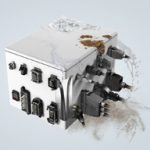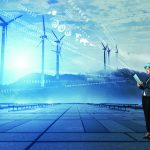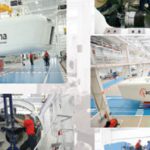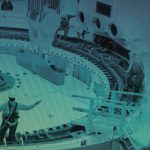As the name implies, wind energy only produces power when the wind is blowing; however, a wind farm is often generating energy even when demands are low. The result is, essentially, wasted electricity.
But what if that wind energy could be stored for future use?
That’s part of the working model behind Hydrogenics. The company makes water electrolyzers. These devices use electricity to split water into hydrogen and oxygen and can be operated in a dynamic way, using renewable power such as wind. The basic principle is that wind farms can create hydrogen from their energy production, allowing the energy to be stored and put to use in fuel cells or used in combination with natural gas for other types of energy needs, according to Angus Brown, marketing manager of Energy Infrastructure with Hydrogenics.
“If you use the excess power that’s not feeding into the grid, you can switch over to generating hydrogen; it’s technically storing the energy that would have typically been wasted, which is generally the biggest criticism you hear of solar or wind is that it’s only good when the wind is blowing or the sun is shining,” he said. “We offer a solution to get more value out of your wind and other renewable energy assets. Additionally, with renewable energy prices dropping and more and more fuel cell applications being developed, the demand for emission-free green hydrogen is on the rise, and wind farms can now utilize their assets in different ways to serve new markets. Hydrogen can actually be a catalyst for more wind energy growth as water electrolyzers offer the means to balance variable wind energy and supply hydrogen to refueling stations or for industrial needs.”
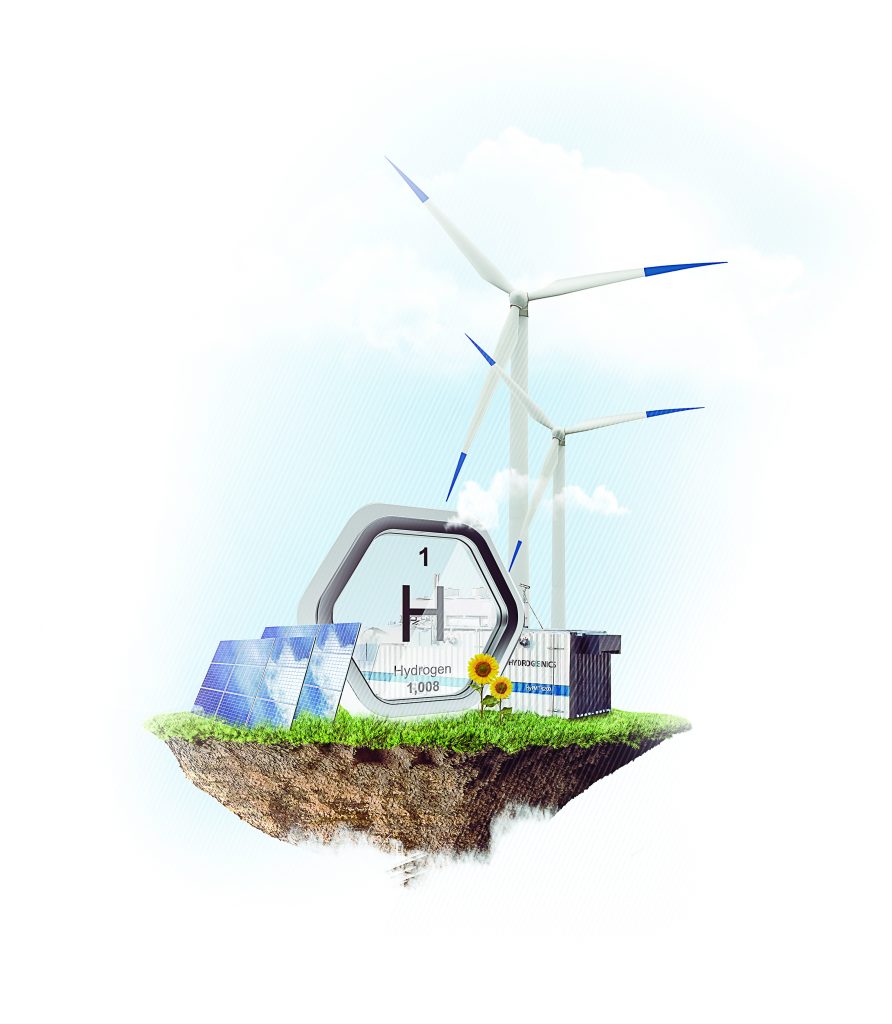
Expanding expertise
When Hydrogenics began more than 70 years ago as the Electrolyser Corporation, it was creating hydrogen with water electrolyzers primarily for industrial use. Later, in the ’90s as Hydrogenics, the company expanded into hydrogen fuel cell production. Hydrogen fuel cells use hydrogen in combination with oxygen from the air to generate power and pure water as a byproduct without any harmful emission released in the atmosphere, making it a very attractive “zero-emission” solution for power generation in electric vehicles and stationary power generation.
“It was a strategic decision on our part to ensure that we understood both sides of the hydrogen equation,” Brown said.
Eventually, that company expansion focused on it complementing renewable energy. “Over the last 10 years, we’ve really turned toward looking at renewable hydrogen,” Brown said. “Wind is obviously one of the cleanest, cheapest, and most accessible power sources that we can harness to generate carbon-free renewable hydrogen.”
With wind and other renewables such as solar and hydro used to generate hydrogen, it’s a step closer to a zero-emissions economy, according to Brown. Several regions of the world, such as Germany, Japan, California, China, and Australia, already are at the forefront of this movement.
“Wind and solar are still always going to be essential pieces of a healthy energy mix,” Brown said. “Hydrogen and wind complement one another. You can actually use hydrogen to harness the full value of wind.”
Safe production
Brown also makes a case that hydrogen, despite its volatile nature, is quite safe, historically speaking.
“It’s actually a fairly safe commodity in terms of its long track record,” he said. “And there are numerous safety precautions that are put into place.”
Much like the industrial gas sector, there are monitoring systems, as well as preventive maintenance safeguards that carefully look for inconsistencies that could result in a problem, Brown said. For Hydrogenics, safety has always been at the core of the design and operation of its products.
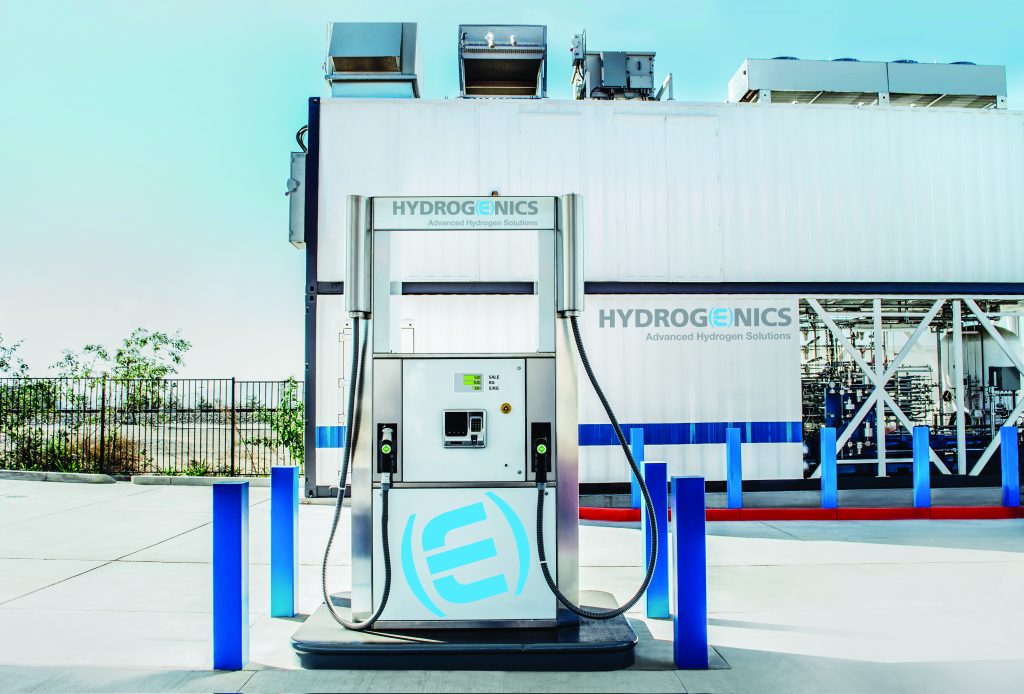
Decades of experience
Since Hydrogenics has been an established supplier of hydrogen for so long, its experience and customer relationships have played strongly into how it generates new business, according to Brown. And sometimes that success becomes evident when bigger companies notice. Air Liquide entered into a $20.5 million (U.S.) Private Placement with Hydrogenics earlier this year, and Fortune 500-ranked Cummins Inc. is actively trying to acquire Hydrogenics.
“When people talk about the top three fuel cell or hydrogen generation companies, generally we’ll always float to the top,” he said. “And a lot of it is word of mouth and project recognition. We have the largest hydrogen generation facility being built in Quebec right now, and it’s going to be run on renewable hydroelectric power. When you start looking around to see where the big energy-storage products have occurred, we’ve been fortunate enough to be involved in most of them.”
That means Hydrogenics often gets inquiries from companies new to the hydrogen game and who are wanting to get involved, perhaps for the first time, according to Brown. Getting started can involve a lot of moving parts, and Hydrogenics has gotten quite proficient at understanding and navigating them.
Ways hydrogen can help
Location and local utilization of hydrogen is often a key factor in determining the viability of a hydrogen project. If a wind farm is in a remote location and there is not an immediate need or use for hydrogen, it may be difficult to find an economic business case as hydrogen transport can be costly. But there are many situations where the logistics and need for fully decarbonized power and/or power storage make the business case for hydrogen very compelling.
Once hydrogen is generated, it can be used for a variety of applications requiring high-quality and low-carbon hydrogen for their processes, such as the ammonia and oil industries. It can also be used to supply hydrogen to refueling stations for Fuel Cell Electric Vehicles (FCEVs), or even to reduce overall emissions from natural gas by supplementing it with hydrogen directly into the natural gas grid for utilities.
“Sometimes it’s a combination of political will around the emission-free aspects as well as the regional need for the hydrogen, and sometimes it’s just a matter of capturing and storing wind, solar, or hydro capacity in a way that be commoditized,” Brown said. “That’s what you’re seeing between Japan, New Zealand, and Australia — who are developing hydrogen as an international commodity, as well as utilizing it locally to decarbonize their power and transportation sectors. With the declining costs of renewable energy and declining costs of electrolyzer technology to produce hydrogen, prices are already competitive with and will soon be lower than producing hydrogen from traditional methods such as reforming fossil fuels, which generates significant quantities of CO2 in the atmosphere.”
Hydrogenics has been successful in implementing similar hydrogen production through wind energy in several places around the globe, according to Brown.
For example:
In Thailand, the EGAT Lam Takhong Wind Hydrogen Project used curtailed energy from a 24-MW wind farm to generate hydrogen, which was used to power the facility using 300 kW fuel cells.
At a German wind farm, excess energy is used to create hydrogen that is fed into the local gas pipeline and used in a hydrogen refueling station for cars and buses, helping to reduce the region’s carbon footprint.
And in Belgium, the extra power from a wind farm is used to produce hydrogen, which is then used in fuel-cell powered forklifts.
Reducing carbon emissions
The word is spreading about what Hydrogenics can do to reduce carbon emissions by using wind and other renewable energy in ways that go beyond the status quo, but also seem to make a lot of common sense as well.
“What we’ve seen over the last few years is a pickup in the fuel-cell business for transportation, and that’s having a trickle-down effect on demand for generation,” Brown said.
And the need to diversify a wind farm’s workload becomes even more compelling as energy contracts near their end, according to Brown. Once those contracts end, a wind farm can become a stranded asset.
“Once your supply contract expires, you’ve got to renew it. If you could renew it at a decent price, great, you can still contribute toward the grid, but if you can’t or if it’s only an intermittent supply, then how do you fully utilize your wind assets?” he said. “Generation of hydrogen is a great opportunity. Like with all renewables, for them not to be utilized at every opportunity when the sun is shining or the wind is blowing is a shame. Additionally, by combining wind and hydrogen generation, renewable hydrogen costs can be secured over a long period of time and act as a hedging mechanism for large industries against hydrogen produced from natural gas — an important consideration in a global economy that is increasingly putting value into reducing CO2 emissions.”
Compact and economical
Hydrogenics’ electrolyzer technology has a small footprint, according to Brown, and it can be scaled dramatically.
“It can be placed almost anywhere,” he said. “Whether or not you just have excess power to utilize or you want your entire wind farm to generate nothing but hydrogen, the electrolyzers can be modularized and scaled to fit a variety of power ranges.”
And as the technology becomes more commonplace, the costs inevitably fall, making it an even more viable option in the future, according to Brown.
“The cost of the electrolyzers, as well as the cost of fuel cells, have fallen dramatically over the last 10 years,” he said. “Where the technology was once seen as a little bit of a novelty, it’s now market proven and becoming more and more economically feasible. Plus, if you account for the emission restrictions and carbon taxes being applied all around the world, the economic case has never been better for hydrogen.”



















